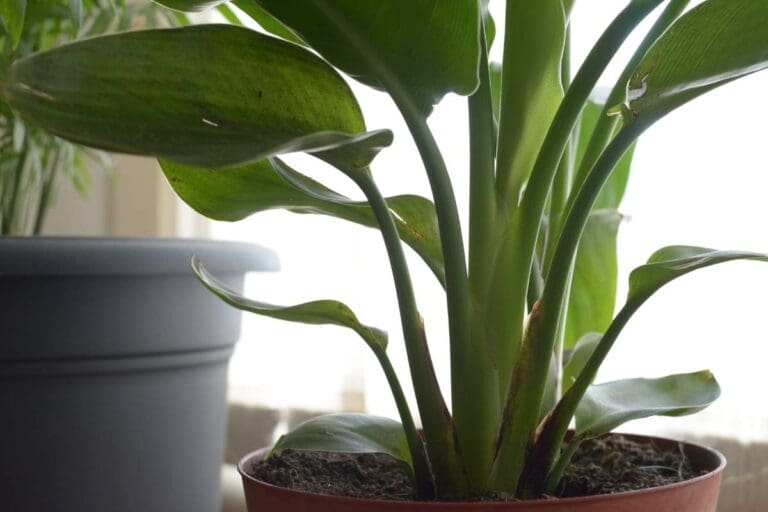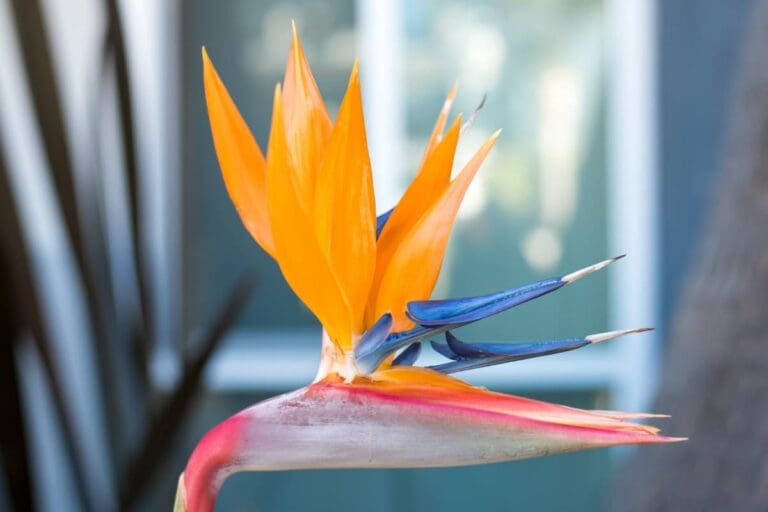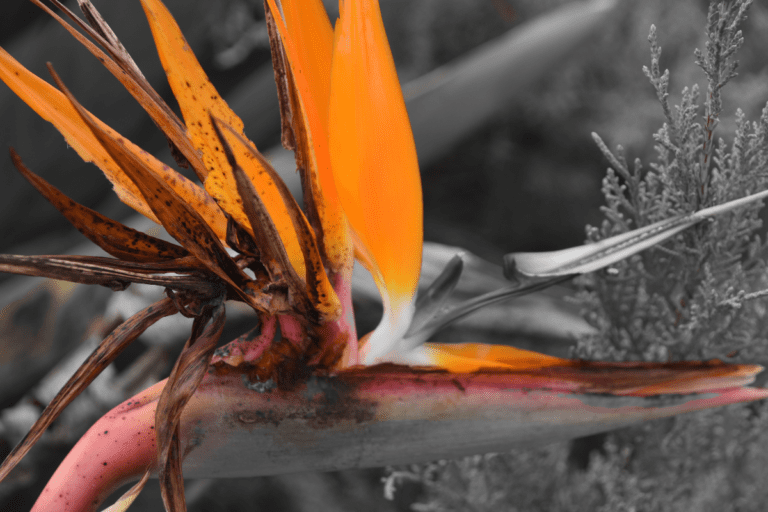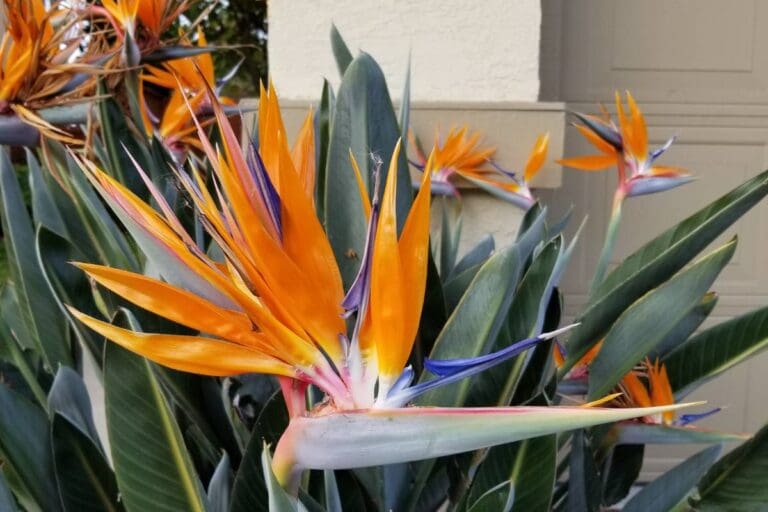Why Is My Bird of Paradise Sticky? (2 Causes+Fix)
The bird of paradise is a gorgeous houseplant known for their giant leaves and unique flowers. However, seeing their leaves becoming sticky is disappointing. But do you know what causes your bird of paradise to plant leaves to become sticky?
Pest attack is the most common reason that causes sticky leaves in your bird of paradise plant. The pests feed on the sap secreted by the plant and excrete a sticky substance called honeydew. Another cause for stickiness in leaves is guttation from its leaves.
This article will help you to identify the reasons and that causes of sticky leaves in your bird of paradise plant, and it will also discuss how to fix them. So, keep reading.

Please note: Simplify Plants is reader-supported. Some links in the post are affiliate links and I get a commission from purchases made through links in the post.
Causes of a sticky bird of paradise plant
One day while pruning my bird of paradise plant, I noticed its leaves felt sticky.
Upon inspection, I noticed some pests feeding on its leaves.
The honeydew excreted by the pests is the main reason behind the stickiness.
So, I started finding ways to eliminate these pests from my plant without wasting more time.
After that, it didn’t take me long to remove pests from my plant and help it recover.
Since I have faced this problem, I want to help you fix your bird of paradise if its leaves have become sticky.
The leaves of a pest-infested plant will look old, sticky, limp, and discolored.
If your bird of paradise plant has a pest infestation, you must take immediate action to save it.
Let us briefly discuss how pests damage your bird of paradise plant and what measures you can take to save it from further damage.
1. Pest infestation
Pests are nightmares for any houseplant.
Unfavorable growing conditions like cold temperatures, high humidity, poorly drained soil, and an unclean environment can attract pests and fungal diseases to the plant.
Common pests that can infest the bird of paradise plant are mealybugs, spider mites, aphids, scales, whiteflies, etc.
My bird of paradise plant has a mealybug infestation.
The pests feed on the plant’s sap, making it weak and vulnerable, and they can also kill the plant if they remain unnoticed.
The sap is the nutrient-rich fluid that gives the plant strength, energy, and growing power.
When the pests suck sap, the plant loses its strength and energy and weakens.
After feeding on the plant, the pests excrete a sticky substance called honeydew.
The sap has sugar content, due to which the honeydew is sticky.
Various other insects, like ants, get attracted to the honeydew causing further damage to the plant.
You may find mold and fungal growth, causing more injuries and damage to the plant.
If you find pests, please take the necessary measures to remove them from your plant and wipe off the honeydew to avoid future infestations.

Identifying pests that may cause sticky residue on your bird of paradise plant
Various pests can cause sticky residue on your bird of paradise plant.
Let us now understand each of the pests in detail.
1. Mealybugs
Mealybugs are small, soft-bodied, wingless insects that look like white cottony masses on the plant parts.
They have long piercing mouthparts called stylets, which they use to suck sap from the plant tissues.
They spread very quickly and can cause leaf yellowing and curling.
Their feeding is accompanied by honeydew which makes leaves sticky and encourages the growth of sticky mold.
2. Aphids
Aphids are tiny, soft creatures with slender mouthparts that pierce leaves, stems, and other tender parts to suck fluid from them.
They stay on the lower part of the leaves, and their attack can cause the leaves to turn curly, wilted, and damaged.
Aphids multiply very quickly, so controlling them is essential before they start reproduction.
They excrete honeydew after feeding on the plant, which encourages mold growth and fungal diseases like powdery mildew.
3. Whiteflies
The whiteflies are tiny, soft-bodied winged insects that feed on the underside of leaves.
They use their piercing mouthparts to suck plant juices and produce a sticky substance called honeydew.
The excretion of honeydew can cause fungal diseases in the plant, like sooty mold.
The plant becomes extremely weak and fails to carry photosynthesis if there is a heavy infestation.
The leaves will wilt, turns yellow, growth gets stunted, and they eventually wither and fall off.
4. Spider mites
The spider mites are tiny, reddish brown, oval-shaped insects that mostly live in colonies on the underside of leaves.
They form a web structure on the leaves, which isn’t visible to the naked eye.
However, if the bottom side of the leaves is sticky, it’s because of spider mites.
They feed on the plant by piercing the leaf tissues and sucking sap.
The continuous feeding will cause the plant leaves to turn yellow, dry, and drop off.
5. Scales
The scales are small insects having a body covered with a protective waxy shell.
These sap-sucking insects attach to plants’ leaves, branches, and twigs.
They use their hair-like mouthparts to feed on the plant tissue and suck out the sap, damaging the plant.
The scales are oddly shaped insects that resemble small yellow or brown bumps on the stems and leaves.
A heavy infestation will lead to poor growth, reduced vigor, and yellow leaves of your plant.
Remedies for getting rid of sticky residue on a bird of paradise plant

Cleaning your bird of paradise plant and removing as many pests as possible is essential for removing the sticky residue.
The severity of treatment depends on the extent of pest infestation on your plant.
Let us understand the natural remedies to remove the sticky residue from your plant.
1. Mealybugs treatment
Follow the below steps to treat mealybugs in your bird of paradise plant.
- Firstly you must isolate your bird of paradise to prevent the pests from spreading to other houseplants.
- Mealybugs are very small, and you can easily overlook them, so you must check the entire plant carefully to know the extent of the damage.
- Prune the yellow, damaged, and infected leaves from your plant.
- Wash your plant thoroughly to remove the pests.
- Next, clean the infected area of the plant with cotton balls dipped in an isopropyl solution.
- You can release some lacewings and ladybeetles in your plant to feed on mealybugs.
- Spray the entire plant with a neem oil solution. It is one of the best natural pesticides against pests.
- If bugs are still present in your plants after following all these steps, use a dish wash solution to remove them. Mix 3 to 4 drops of dish wash and a cup of isopropyl alcohol in 1 quart of water and spray this solution on the leaves.
- If there is a severe infestation, treat your plant with pesticides after following the necessary precaution.
- Keep your plant in a well-ventilated, less-humid region to prevent future infestation.
2. Aphid treatment
Follow the below steps to treat aphids in your bird of paradise plant.
- Firstly, handpick the aphids and put them in a soap-filled jar.
- Next, shower your bird of paradise plant with water. After washing, keep the plant in sunlight to dry out its leaves.
- You can release ladybugs on your plant to help eliminate aphids.
- You can remove the pests by spraying the plant with warm water and detergent soap. After that, rub the infected parts with a wet cotton ball.
- If your plant still has aphids, spray by adding a tablespoon of neem oil and a tablespoon of dish wash in one gallon of water. Spray the solution on the leaves and continue doing it every 2-3 weeks to remove the aphids altogether.
3. Whiteflies treatment
Follow the below steps to treat whiteflies in your bird of paradise plant.
- Firstly, shower your bird of paradise plant with a hose to remove whiteflies. Put more focus on the undersides of leaves since whiteflies mostly hide there.
- You can put yellow sticky traps on your plant to catch the whiteflies. The pests get attracted to yellow, so using these traps effectively captures them.
- Prepare a solution by mixing water and vinegar in equal amounts and wipe the leaves with a cotton swab using this solution.
- To treat the severe infestation, spray the plant with insecticidal soaps.
4. Spider mites treatment
Follow the below steps to treat spider mites in your bird of paradise plant.
- To get rid of spider mites, handpick them as much as possible and wash the plant with water to remove the leftover scales.
- You can also apply natural insecticides like neem and horticulture oil to remove pests. They are non-toxic and highly effective for treating pests.
- You can also make an effective spray with 1 teaspoon of isopropyl alcohol and 2 teaspoons of neem oil in 1 quart of water. Spray this solution over the plant if it has a heavy infestation.
- At last, prune the infected and damaged leaves after spraying the plant and check your plant regularly to prevent future infestations.
5. Scales treatment
Follow these steps to treat scales in your bird of paradise plant.
- Using toothpicks or forceps, you can remove scales from your bird of paradise plant.
- If there is a light infestation, prepare a solution by adding 1 teaspoon of liquid dish wash soap in 1 quart of water and wipe the leaves using this solution.
- Rubbing alcohol is highly effective for treating scales. So you can also rub the infected areas of the plant with cotton swabs dipped in rubbing alcohol.
- You can also use insecticidal soap to remove pests from your plant.
2. Guttation in bird of paradise plants

The bird of paradise plant can sometimes release a sticky substance from their leaves.
This situation will occur when the plant is highly saturated and can’t absorb water anymore.
In that case, the plant releases excess water from its leaves.
This process of eliminating excess moisture is called transpiration.
The plant sometimes releases sap and water during transpiration, making the leaves sticky.
This situation is known as guttation.
If you discover the leaves sticky but don’t find any pests and notice watery crystals, it is because of guttation.
Guttation is natural and doesn’t harm plants.
But whenever you find sticky leaves because of guttation, clean them as they can lead to various pests and fungal diseases in the plant.
Is too much guttation dangerous for a bird of paradise plant?
Guttation is a natural process of removing the extra water from the plants through their leaves.
However, excess of anything is harmful to the plants.
If your plants have higher guttation, it might be because you are overwatering the soil.
The plant will lose all its essential nutrients if guttation is high.
The leaves of your bird of paradise plant will get burn marks if there is too much guttation.
To prevent excessive guttation in your plant, you can follow the following tips given below.
- Avoid overwatering your plant. When you overwater, plants will fail to absorb the excess water and will transpire more, increasing the guttation rate.
- Avoid keeping your plant in a highly humid region and maintain the ideal humidity range. Ensure the plant is getting sufficient air and light.
- Avoid over-fertilizing your bird of paradise plant. When you over-fertilize your plant, there will be salt and mineral build-up in the soil, which can result in leaf burns and increased guttation.
- Avoid tap water and use only distilled or filtered water to water your plant. Tap water has minerals like fluorine and chlorine that can increase the guttation rate.
How to clean sticky residues off a bird of paradise plant?

The honeydew excreted by pests is the primary reason for the sticky leaves in your bird of paradise plant.
So, cleaning the plant is vital for removing the sticky substance and repelling pests.
Below I mentioned some ways which you can follow to keep your plant leaves clean.
- Mix 1 teaspoon of liquid dish wash soap or detergent in 1 quart of water.
- Dip a cotton ball in this mixture and wipe off the leaves.
- Clean both sides of the leaves nicely, as pests can hide anywhere.
- I also use isopropyl alcohol to clean my plant’s leaves, which cleans well.
Preventing sticky residue on your bird of paradise plants
You can prevent the sticky residue on your bird of paradise plant by following the tips below.
- Grow your bird of paradise plant in a place that provides bright indirect light with a few hours of direct light. Avoid keeping the plant in a low-light area, as it can become more prone to pests and fungal attacks.
- Keep the soil moist but not soggy. Consistently damp soil can become the breeding ground for pests.
- Keep your bird of paradise plant in a well-ventilated area to ensure plenty of airflow around it.
- Check your plant regularly for any pest infestations.
- Spray the plant with neem oil or horticulture oil solution once every month to keep pests away.
- I clean my plant’s leaves with soapy water once every month to keep it dust free and healthy.
Final words
Pest infestation and guttation are the reasons behind the sticky leaves on your bird of paradise plant. If your bird of paradise plant has sticky leaves, check it thoroughly for any infestation.
If you notice pests, take immediate action for your plant’s recovery. If guttation is cause for stickiness, clean the leaves and avoid overwatering the plant. Ensure your bird of paradise plant gets ideal growing conditions to prevent sticky leaves.
How long will it take for my bird of paradise plant to recover from a pest infestation?
My bird of paradise plant took 2-3 weeks to recover as it had a light pest infestation. However, if the infestation is heavy, the plant can take a few months to a year to recover completely. Providing the plant with favorable growing conditions and care will help it recover early.
What is the sticky white powder on my bird of paradise plant?
The sticky white powder on your bird of paradise indicates a fungal disease called powdery mildew. You will find a white or grey powdery coating on the infected leaves and stems. The fungal diseases will lead to leaf yellowing and dropping.
Reference: Wikipedia
Recommended Garden Supplies
| Product Image | Our Recommended Gardening Supplies | Check Offers! |
|---|---|---|
Top Top
Top
Top
Top
Top
Top
Top
Top | rePotme Houseplant and Tropical Classic Potting Soil Mix | Check Offer On Amazon |
 Top
Top
Top
Top
Top
Top
Top
Top | Espoma Organic Indoor Plant Food | Check Offer On Amazon |
 Top
Top
Top
Top
Top
Top
Top
Top | GooingTop LED Grow Light 6000K Full Spectrum Clip Plant Growing Lamp | Check Offer On Amazon |
 Top
Top
Top
Top
Top
Top
Top
Top | Soil Moisture Meter | Check Offer On Amazon |
 Top
Top
Top
Top
Top
Top
Top
Top | Govee Hygrometer Thermometer, Bluetooth Enabled! | Check Offer On Amazon |
 Top
Top | LEVOIT Humidifiers for Large Room(Best For Plants) | Check Offer On Amazon |
 Top
Top
Top
Top
Top
Top
Top
Top | Upgraded DIY Automatic Drip Irrigation Kit, 15 Potted Houseplants Support | Check Offer On Amazon |
 Top
Top
Top
Top
Top
Top
Top
Top | Stainless Steel Heavy Duty Gardening Tool Set | Check Offer On Amazon |
 Top
Top
Top
Top
Top
Top
Top
Top | Bonide Insecticidal Soap | Check Offer On Amazon |
 Top
Top
Top
Top
Top
Top
Top
Top | Bonide 32 oz Spray Neem Oil for Organic Gardening | Check Offer On Amazon |
 Top
Top
Top
Top
Top
Top
Top
Top | Garden Safe Fungicide | Check Offer On Amazon |






My brother suggested I might like this website. He was totally right. This post actually made my day. You cann’t imagine just how much time I had spent for this information! Thanks!